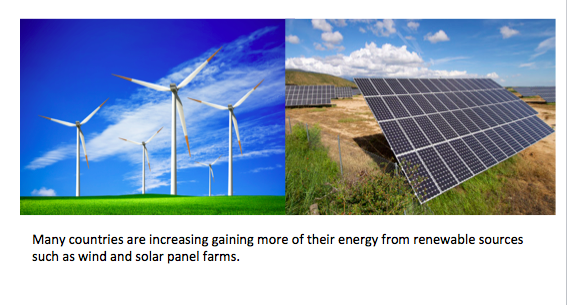C.1 Energy sources
Written specifically for students to provide help and support for the IB Diploma chemistry programme this page provides full coverage of the syllabus content of Option C - sub topic C.1. It encourages you to think critically and provides many questions with full worked answers so that you can monitor and improve your knowledge and understanding.


 Learning outcomes
Learning outcomes
After studying this topic you should be able to:
 Understand:
Understand:
- Useful energy sources are able to releases energy at a reasonable rate and produce minimal pollution.
- As heat is transferred to the surroundings the quality of energy is degraded. Energy and materials go from a concentrated into a dispersed form and the amount of the energy available for doing work decreases.
- Sources of renewable energy are replenished naturally. Sources of non-renewable energy are finite.
- The energy density = energy released from fuel ÷ volume of fuel consumed.
- The specific energy = energy released from fuel ÷ mass of fuel consumed .
- The efficiency of an energy transfer = (useful output energy ÷ total input energy) x 100%.
Apply your knowledge to:
- Discuss the use of different sources of renewable and non-renewable energy.
- Determine the energy density and specific energy of a fuel from the enthalpies of combustion, densities and the molar mass of the fuel.
- Discuss how the choice of fuel is influenced by its energy density or specific energy.
- Determine the efficiency of energy transfer processes from appropriate data.
- Discuss the advantages and disadvantages of the different energy sources covered in all the sub-topics of this option.
Relationships & vocabulary
Nature of science
Energy has both quantity and quality. The energy changes in the world around us are as a result of potential and kinetic energy changes at the molecular level.
International-mindedness
The International Energy Agency (IEA), an autonomous organization based in Paris, works to ensure reliable, affordable and clean energy for its 29 member countries and beyond.
The International Renewable Energy Agency (IRENA), founded in 2009, is based in Abu Dhabi, UAE. It works to promote the widespread adoption and sustainable use of all forms of renewable energy, including bioenergy, geothermal, hydropower, ocean, solar and wind energy in the pursuit of sustainable development, energy access, energy security and low-carbon economic growth and prosperity.
Vocabulary
| renewable energy | non-renewable energy | energy density | specific energy | efficiency of energy transfer |
Learning slides
You can use this slide gallery for learning or for reviewing concepts and information. It covers all the key points in the syllabus for this sub-topic.
Something to think about

This sub-topic looks at different energy sources and their efficiency in actually providing the energy required for society, as it currently exists, to function. It is a sobering thought that when we turn on a traditional incandescent 60W electric light bulb less than 1% of the raw energy consumed is actually converted into light. It has been calculated that it requires 200-300 kg of good quality coal to power just one 60 W light bulb for one year. 99% of the raw energy is wasted in the supply chain. If the raw source is a conventional fossil fuel then 10% of the energy is lost during combustion. Of the 90% that is transferred to steam to drive the steam turbine only 40% is transferred into mechanical energy and a further 2% is lost in converting this into electricity. The transmission of electricity through the grid system from the power station to the consumer’s home loses a further 10% and the incandescent light bulb itself is particularly inefficient converting only about 2% of the received electrical energy into light.

Image from Electropaedia
What this demonstrates is that while it is important to use more renewable sources to minimise climate change etc. in the future, the most significant change required is to make the transfer of energy from the raw source to the end user as energy efficient as possible.
Test your understanding of this topic
(Note that your teacher may have restricted your access to some or all of these questions and worked answers if they are going to use them as a class test or set them as an assignment.)
For ten 'quiz' questions (for quick testing of knowledge and understanding with the answers explained) see MC test: Energy sources.
For short-answer questions see Energy sources questions together with the worked answers on a separate page Energy sources answers.
More resources
1. Ten future energy sources that can replace fossils fuels.
2. Energy efficiency - how we can get more from less.
3. A useful chart from Energy4me comparing the pros and cons of different energy sources

 IB Docs (2) Team
IB Docs (2) Team 










